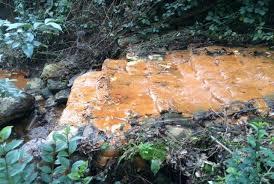
What is Iron Bacteria?
Condition: Orange-Red Surface film or floc-like deposits in slow moving water or pond areas.

This is normally a naturally occurring phenomenon resulting from iron bacteria growth. It is generally associated with acidic soils, or can be enhanced by iron in surface runoff. This condition may be especially evident after heavy rains, when iron leaches from the soil.
These harmless bacteria "bloom" when oxygen, water and iron combine. The bacteria are typically rust-colored and appear oily. They form masses composed mainly of the iron oxide-accumulating bacterium Leptothrix.
Iron bacteria undergoes an oxidation process (change their compound structure) to fulfill its energy requirements. This involves changing ferrous iron (Fe2+) into ferric iron (Fe3+). This process makes the iron insoluble and produces the rust-colored slimy deposit in stream beds.
A byproduct is a bacterial film which will break up if disturbed. If the substance is an oil spill, it will flow back into place after being disturbed.
Related Links:
- What's the Red? - U.S. Geological Survey - includes how to collect and observe the microbes
- Growth of Iron Bacteria - University of Wisconsin